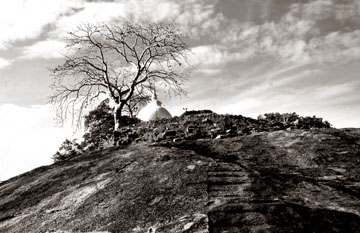|
observer |
|
|
|
|
|
OTHER LINKS |

|

|

|
Walk into the jungle of Sithulpahuwa
|
|
|
The grazing herd of spotted deer, silhouetted against the setting sun, remained motionless as I rounded the bend into the villu, one of hundreds of lakes where jungle denizens quench their thirst. After a few seconds of inspection, the deer were back at it, while the proud male crowned with long antlers kept a wary eye on this new human intrusion.
I was a few kilometres inside the magnificent Ruhunu Wildlife Sanctuary at a famous archaeological site called Sithulpahuwa. However, the site is not only famous for its 2nd Century BC monastery, but also for its majestic dagobas and its rock carvings. What appeals most to visitors is the jungle wilderness and the panoramic view of the 1,300-square-kilometres wildlife sanctuary, which runs right down up to the Indian Ocean.
Five kilometres from Tissamaharama, the usual watering point for thirsty animals on their way to the Yala Wildlife Park, a dirty track branches off the main road. The road sign almost hidden behind a nearby tyre-repair shop, says " To Sithulpahuwa". On bright days, the dirt track is smoother than the macadamized main road. When it rains, though, it can be disastrous. A half-hour drive down the track through breathtaking country that progressively becomes dense jungle brings travellers to a barrier point, manned by a courteous game warden.
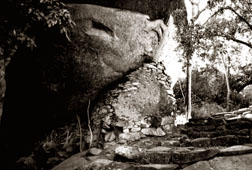 The remnant walls of the meditating rooms used by the monks in the past |
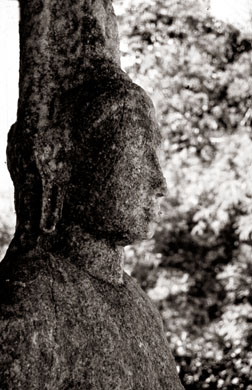 Ancient ruins of Bodhisatva statue |
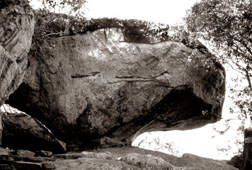 The umbrella-shaped rock |
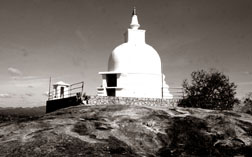 The majestic dagoba of Kuda Sithulpahuwa |
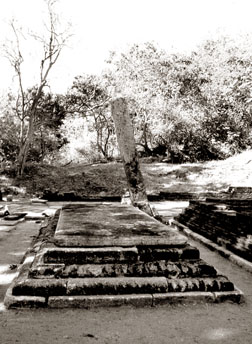 The ruins of ancient stone structures scattered in the monastic site. |
From here it is another half-hour drive to Sithulpahuwa, the ancient monastery site, believed to be one of the few of its kind in Sri Lanka where monks practise Mahayana Buddhism in contrast to Hinayana Buddhism, which has been the accepted form of Buddhism since Lord Buddha's teachings were first brought to Sri Lanka in the 5th Century BC.
Today, the monastery that was acclaimed as the greatest of its time still stands, although numerous renovations have been made to the original structure. More recently the addition, the pilgrim's rest clustered around an artificial lake, known for its man-eating crocodiles, which crawl out onto the banks at noon to sun themselves.
Sithulpahuwa gets its name from the huge rock on which the dagoba was built. The word pahuwa a derivation of the word pawwa, means a (big rock) in Sinhala. The dagoba on the top of the rock is not as ancient as the rest of the monastery. It has been built over the original dagoba and was reconstructed a few years ago. On the lower slopes, however, one can find the foundations of two ancient dagobas to the original. According to folklore, some holy relics of lord Buddha were hidden in the original dagoba, and the remains of two of His principal disciples were placed inside the two companion dagobas.
From the top of the rock mountain, the traveller can see the whole of the Ruhunu Sanctuary, right down to the sea on the side and to the central hills on the other. Built into a side of the rock is a shrine room, containing a statue of Lord Buddha and of His two principal disciples. Scattered around the site are more than 60 inscriptions identifying Sithulpahuwa as a monastery of celebrated piety and scholarship. But more interesting to the adventurous traveller is a little path that leads out from near the shrine room. There are no signposts. Less than a kilometer away through the jungle, the path leads to a small dagoba, seen atop another rocky outcrop, which is even higher than Sithulpahuwa. For those whose interest extends beyond archaeology, this is exciting as it takes the traveller into the middle of the wilderness, where - save for the cacophony of jungle sounds-peace prevails.
A few yards up, an umbrella-shaped rock forms a passage, leaning against another rock. Beneath the first are indications of the beliefs of the village people. Stacked against the rock are hundreds of little sticks and branches. The villagers break the branches and offer them to the jungle deities for protection, before they venture too far into the jungle.
The traveller has to climb up a near- vertical rock face, supported by a rickety iron hand-rail and tiny footholds carved into the rock, before climbing up the second rock mountain. The effort is worth it. The panaromic view is even better from there.
The second dagoba is called Kuda Sithulpahuwa. Historians claim it was once linked to the main monastery by a paved path fringed with flowering bushes. On both sides of the path were caves and rooms in which the monks could meditate. Today, the more adventurous can even venture off the main path and find remnants of these caves and rooms.
The authorities in the temple advise that travellers return to the main monastery before sunset. However, once the heady view envelopes you, such advice may soon be forgotten.
